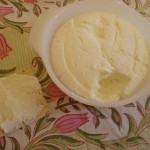Fresh Cheese
Unlike yogurt cheese — this is a “real” cheese for which you use rennet and everything.
There’s a biology/chemistry professor in Cincinnati who has a terrific website about making cheese, and I followed his instructions for “Neufchatel” cheese. (Although I did half a recipe — I didn’t use all my weekly milk share.)
This was really interesting — first you gently heat the milk, add a little souring agent (I used yogurt) and a tiny bit of rennet dissolved in water. Then you let it sit overnight. By morning, you have curds — which to me looked exactly like very soft fresh tofu — that same sort of slippery, shiny texture. You cut the curds — the instructions said to cut them into fairly big pieces — and then ladle it all into a collander lined with cheesecloth. You twist the cheesecloth so the cheese is in a tight ball, secure it with a rubber band, and hang it to drain. I used my deepest stockpot, and suspended the cheese from a wooden spoon balanced on the top of the pot. The whey collected in the pot, and I could put the whole thing in the pantry where it’s cool.
The only mistake I made was not being patient enough. I didn’t let the cheese hang long enough, and although I tried some on toast, I didn’t like the texture. It was still weirdly slippery. So I put it back in the cheesecloth and let it hang for another seven or eight hours. That did the trick — the texture is now somewhat like a nice fresh goat cheese. It’s not quite as chalky, probably because Isabelle’s Jersey cows give very rich milk, but neither does it have that gummy quality of commercial cream cheese. It’s very fresh tasting, with a nice clean milk taste, that is just a tiny bit sour (in the way yogurt is a little sour — not sour like milk that’s off, just sour like milk that’s been fermented).
I’m very pleased with my first cheese. Who knows? Maybe this will be my recession plan — I’ll learn to make cheese. Considering the way things are going, I might need to …

9 thoughts on “Fresh Cheese”
and them you can sell it to the French!
Parfait!
PS today’s anit-spammer words are definitely trying to tell me something! If only I knew what!
Goat cheese and cow cheese are different in the amount of fat in the milk. goat cheese produces more cheese per volume than does cow cheese, but both are good. Just wait until you move on to making cheddars, and other hard cheeses, you will be very happy with your home made results.
Good work.
I made cheese this weekend, too. I made mozzarella. It takes about an hour from millk –> cheese. You heat it in the microwave. I had to use store-bought milk but it was still good!
http://www.cheesemaking.com/30-Minute-Mozzarella-Ricotta-Kit.html
I just read the neufchatel instructions and it sounds easier than the mozzarella, and less messy. What did you do with all the whey? I had at least a quart of whey left over!
I should have saved the whey to do something with — I’ve fed it to the dogs in the past — this time, shamefully, I poured it down the drain. In part because it came in smaller amounts.
And I really liked this recipe (I’ve been making that guy’s yogurt recipe for a year, it’s bombproof). I tried the microwave mozzarella recipe, but something went wrong. I don’t know whether it’s that the Jersey milk I use is so high in milk proteins, but when I tried the mozzarella it went immediately to rubber. So I figured I’d go back to the source, the Cincinnati professor, and take him at his word and go through the easy-to-harder cheese stages.
I want to try yogurt next. The yogurt I had in Turkey was close to heaven, in my opinion, and I have not ever had anything similar in the US; I’m wondering if the ‘labneh’ he describes is what I remember.
I’ve made mozzarella and ricotta, both with very good results. I have a trio of dairy goats coming my way this weekend, and part of my plan for them is to make cheese with my extra milk. Happy cheese making!
Ah, Fankhauser’s cheese page! He’s really good! I also like Fiasco Farm (www.fiascofarm.com). She’s got some tasty recipes too. I prefer her mozzarella recipe to the one at Cheesemaking.com. It has more flavor but is also much more involved.
Enjoy your cheese escapades! I look forward to hearing more about them!
Comments are closed.